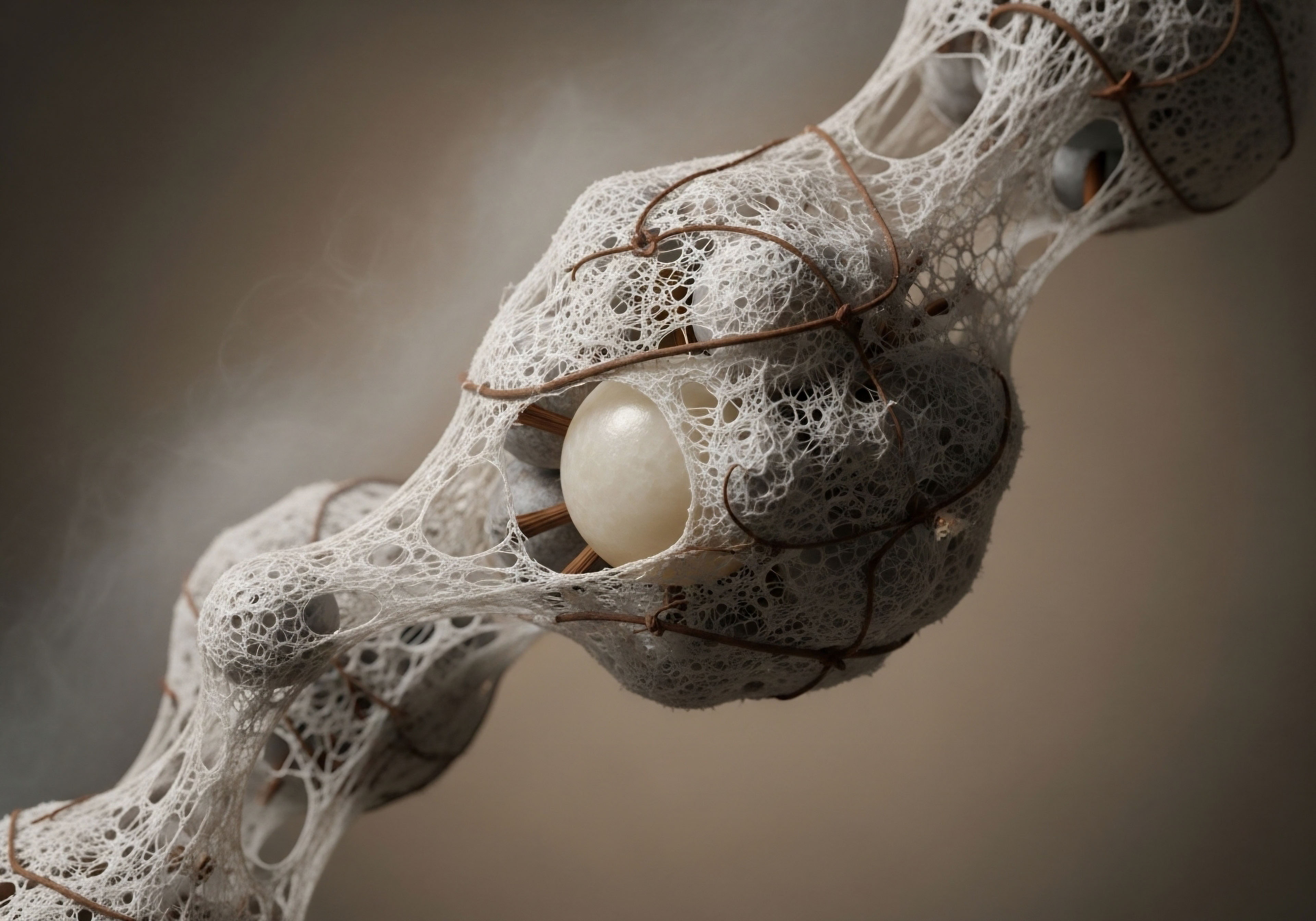

Fundamentals
Experiencing shifts in your vitality, changes in your energy levels, or an unexplained alteration in your overall sense of well-being can be disorienting. You might feel a subtle yet persistent deviation from your usual self, a quiet whisper from your body indicating something is out of sync.
This sensation, often dismissed as simply “getting older” or “stress,” frequently points to the intricate, often unseen, world of your hormonal health. Understanding these internal communications within your biological systems is the first step toward reclaiming your optimal function and feeling truly aligned.
Our bodies operate through a sophisticated network of chemical messengers, and among the most influential are hormones. These molecules act as signals, orchestrating a vast array of physiological processes, from metabolism and mood to reproduction and energy regulation.
When these signals become disrupted, even subtly, the effects can ripple throughout your entire system, impacting how you feel, how you think, and how your body performs. Recognizing these subtle cues from your own physiology is a powerful act of self-awareness, laying the groundwork for a deeper understanding of your unique biological blueprint.

The Hypothalamic Pituitary Gonadal Axis
At the heart of reproductive and sexual health, and indeed a significant aspect of overall vitality, lies the Hypothalamic-Pituitary-Gonadal (HPG) axis. This axis functions as a central command system, a sophisticated feedback loop that governs the production of sex hormones. Imagine it as a finely tuned thermostat for your endocrine system, constantly adjusting and responding to maintain balance. The hypothalamus, a region in your brain, initiates this cascade by releasing Gonadotropin-Releasing Hormone (GnRH).
The hypothalamus, acting as the master regulator, secretes GnRH in a very specific, rhythmic pattern. This pattern is not continuous; rather, it occurs in discrete bursts, or pulses, throughout the day. This pulsatile release is absolutely critical for the proper functioning of the entire axis.
Think of it like a conductor leading an orchestra ∞ the conductor’s precise, rhythmic cues ensure each section plays its part at the right moment, creating a harmonious symphony. If the cues become erratic or continuous, the orchestra loses its rhythm.
Upon receiving these precise GnRH pulses, the pituitary gland, a small but mighty organ situated at the base of your brain, responds by releasing two other vital hormones ∞ Luteinizing Hormone (LH) and Follicle-Stimulating Hormone (FSH). These gonadotropins then travel through the bloodstream to the gonads ∞ the testes in men and the ovaries in women.
In men, LH stimulates the Leydig cells in the testes to produce testosterone, while FSH supports sperm production. In women, LH triggers ovulation and corpus luteum formation, while FSH promotes the growth of ovarian follicles and estrogen production. This intricate sequence ensures the body’s reproductive machinery operates with precision.
The HPG axis, a complex hormonal feedback system, governs reproductive and overall vitality through precise, rhythmic signaling.

The Rhythmic Nature of Gonadotropin Release
The pulsatile nature of GnRH secretion is a fundamental aspect of its biological activity. The frequency and amplitude of these pulses dictate the relative release of LH and FSH from the pituitary. For instance, faster GnRH pulse frequencies tend to favor LH secretion, while slower frequencies can promote FSH release.
This dynamic regulation allows the body to fine-tune its hormonal output based on physiological needs, such as different phases of the menstrual cycle in women or the maintenance of spermatogenesis in men. Disrupting this natural rhythm can have profound consequences for hormonal balance and reproductive function.
When the body’s natural GnRH pulsatility is compromised, whether due to stress, nutritional deficiencies, certain medical conditions, or aging, the entire HPG axis can falter. This can lead to a cascade of symptoms that impact quality of life, including diminished energy, reduced libido, mood fluctuations, and changes in body composition. Understanding the importance of this natural rhythm is paramount when considering therapeutic interventions aimed at restoring hormonal equilibrium.

Introducing Therapeutic Approaches
In the realm of hormonal health, medical science has developed various strategies to influence the HPG axis. Two distinct approaches, often discussed in clinical settings, involve manipulating GnRH signaling ∞ pulsatile gonadorelin therapy and continuous GnRH agonist use. While both involve substances that interact with the GnRH receptor, their mechanisms of action, physiological effects, and clinical applications are fundamentally different.
One aims to mimic the body’s natural rhythm to stimulate hormone production, while the other seeks to override that rhythm to suppress it.
The distinction between these two therapeutic modalities lies in their intent and their interaction with the delicate feedback mechanisms of the HPG axis. Pulsatile gonadorelin therapy seeks to restore a natural physiological pattern, thereby reactivating the body’s own hormone-producing capabilities.
Conversely, continuous GnRH agonist administration aims to desensitize the pituitary gland, effectively shutting down the downstream production of sex hormones. This fundamental difference in approach leads to vastly different clinical outcomes and applications, each tailored to specific patient needs and health objectives.


Intermediate
When addressing hormonal imbalances, the choice of therapeutic intervention hinges on a precise understanding of the underlying biological mechanisms and the desired physiological outcome. The distinction between stimulating and suppressing the HPG axis forms the basis for comparing pulsatile gonadorelin therapy and continuous GnRH agonist use. Each approach serves a unique purpose, calibrated to specific clinical scenarios and patient goals.

Pulsatile Gonadorelin Therapy
Pulsatile gonadorelin therapy involves the administration of synthetic GnRH in a manner that closely mimics the body’s natural, intermittent release pattern. This is typically achieved through a programmable pump that delivers small, precise doses subcutaneously at regular intervals, often every 60 to 120 minutes. The objective is to provide the pituitary gland with the specific, rhythmic stimulation it requires to produce LH and FSH.
The pituitary gland’s GnRH receptors are highly sensitive to the frequency and amplitude of GnRH pulses. When these receptors are exposed to intermittent, physiological pulses, they remain responsive, leading to the sustained release of gonadotropins. This, in turn, stimulates the gonads to produce their respective sex hormones, such as testosterone in men and estrogen and progesterone in women. The body’s own endocrine machinery is reactivated, rather than replaced.

Clinical Applications of Pulsatile Gonadorelin
Pulsatile gonadorelin therapy is primarily employed in situations where the goal is to restore or induce endogenous hormone production and fertility. This often includes conditions characterized by a deficiency in GnRH secretion from the hypothalamus, leading to hypogonadotropic hypogonadism.
- Hypothalamic Amenorrhea ∞ In women, this condition involves the absence of menstruation due to insufficient GnRH release, often linked to excessive exercise, stress, or inadequate nutrition. Pulsatile gonadorelin can restart the menstrual cycle and ovulation.
- Kallmann Syndrome ∞ A genetic disorder causing impaired GnRH secretion and a lack of puberty. Pulsatile gonadorelin can induce puberty and fertility in both men and women with this condition.
- Post-TRT Fertility Restoration in Men ∞ For men who have been on testosterone replacement therapy (TRT) and wish to restore their natural testosterone production and fertility, pulsatile gonadorelin can be a component of a comprehensive protocol. TRT suppresses the HPG axis, and gonadorelin helps to re-stimulate it. This aligns with protocols that might also include medications like Tamoxifen or Clomid to further support LH and FSH levels, alongside Anastrozole if estrogen conversion needs management.
- Idiopathic Hypogonadotropic Hypogonadism ∞ Cases where the cause of low GnRH is unknown.
The administration of gonadorelin in a pulsatile fashion is a sophisticated approach that respects the body’s inherent biological rhythms. It seeks to re-establish a natural feedback loop, allowing the body to regain its capacity for self-regulation. This contrasts sharply with therapies that aim to suppress or replace hormonal function entirely.
Pulsatile gonadorelin therapy mimics natural GnRH rhythms to stimulate the body’s own hormone production, primarily for fertility and HPG axis restoration.

Continuous GnRH Agonist Use
In stark contrast to pulsatile gonadorelin, continuous GnRH agonist administration aims to achieve a state of sustained GnRH receptor activation. While this might initially seem like it would stimulate hormone production, the opposite effect occurs due to a phenomenon known as desensitization or downregulation.
When GnRH receptors on the pituitary gland are exposed to a constant, non-pulsatile presence of a GnRH agonist, they become overwhelmed and lose their responsiveness. Imagine a doorbell that rings incessantly; eventually, the person inside stops responding to it. Similarly, the pituitary cells become desensitized, leading to a dramatic reduction in the release of LH and FSH.
This suppression of gonadotropin release, in turn, leads to a significant decrease in sex hormone production by the gonads, effectively creating a state of “medical castration.”

Clinical Applications of Continuous GnRH Agonists
The primary use of continuous GnRH agonists is to suppress sex hormone production, which is beneficial in conditions where sex hormones contribute to disease progression.
- Prostate Cancer ∞ In men, prostate cancer often relies on testosterone for growth. GnRH agonists like leuprolide or goserelin are used to reduce testosterone levels, thereby slowing cancer progression.
- Endometriosis ∞ This condition, common in women, is estrogen-dependent. GnRH agonists induce a temporary, reversible menopause-like state by suppressing estrogen, alleviating symptoms.
- Uterine Fibroids ∞ Similar to endometriosis, fibroids can be estrogen-sensitive. GnRH agonists can shrink fibroids before surgery or manage symptoms.
- Precocious Puberty ∞ In children, GnRH agonists can halt or reverse premature pubertal development by suppressing the early activation of the HPG axis.
- Gender Affirming Care ∞ Used to suppress endogenous puberty in transgender adolescents.
The continuous administration of these agonists effectively puts the HPG axis into a quiescent state. This suppression is a deliberate therapeutic strategy to mitigate the effects of sex hormones in various disease states. The goal is not to restore natural function, but to temporarily or permanently reduce hormonal activity.
Continuous GnRH agonists induce pituitary desensitization, suppressing sex hormone production for conditions like prostate cancer or endometriosis.

Comparing the Mechanisms and Outcomes
The fundamental difference between pulsatile gonadorelin therapy and continuous GnRH agonist use lies in their interaction with the GnRH receptor and the resulting physiological response. One stimulates, the other suppresses. This distinction is critical for understanding their respective roles in clinical practice.
Consider the analogy of a car’s accelerator pedal. Pulsatile gonadorelin is like pressing the accelerator in short, controlled bursts, allowing the engine (pituitary) to respond optimally and drive the wheels (gonads) forward. Continuous GnRH agonist use, conversely, is like pressing the accelerator down constantly and holding it there. Initially, the engine might rev, but quickly it overheats and shuts down, or the system becomes unresponsive, leading to a complete halt in forward motion.
The table below summarizes the key differences in their mechanisms, indications, and expected outcomes.
| Feature | Pulsatile Gonadorelin Therapy | Continuous GnRH Agonist Use |
|---|---|---|
| Mechanism of Action | Mimics natural pulsatile GnRH release, stimulating pituitary GnRH receptors intermittently. | Provides continuous, non-pulsatile stimulation of pituitary GnRH receptors, leading to desensitization and downregulation. |
| Effect on HPG Axis | Activates and stimulates the HPG axis, promoting LH and FSH release. | Suppresses and inactivates the HPG axis, inhibiting LH and FSH release. |
| Primary Goal | Restore or induce endogenous hormone production and fertility. | Suppress sex hormone production to treat hormone-sensitive conditions. |
| Clinical Indications | Hypothalamic hypogonadism, Kallmann syndrome, fertility restoration post-TRT. | Prostate cancer, endometriosis, uterine fibroids, precocious puberty. |
| Hormone Levels | Increases LH, FSH, testosterone (men), estrogen/progesterone (women). | Decreases LH, FSH, testosterone (men), estrogen (women). |
| Administration | Typically subcutaneous pump for pulsatile delivery. | Subcutaneous or intramuscular injection, often depot formulations for sustained release. |
Understanding these distinctions is paramount for clinicians and patients alike. The choice between these therapies is not arbitrary; it is a deliberate decision based on the specific physiological problem and the desired therapeutic effect. One aims to restore a natural rhythm, the other to intentionally disrupt it for a specific medical purpose.


Academic
The profound differences between pulsatile gonadorelin therapy and continuous GnRH agonist administration extend beyond their immediate clinical applications, delving into the molecular intricacies of receptor dynamics, signal transduction pathways, and the broader systems-biology implications for long-term health. A deep exploration of these mechanisms reveals why one approach revitalizes endogenous hormonal function while the other induces a state of profound hormonal suppression.

GnRH Receptor Dynamics and Signaling
The GnRH receptor (GnRHR), a G protein-coupled receptor (GPCR), plays a central role in mediating the effects of GnRH on pituitary gonadotrophs. The pulsatile nature of natural GnRH secretion is critical because it optimizes the responsiveness of these receptors. When GnRHRs are exposed to intermittent pulses, they undergo a cycle of activation, internalization, and recycling back to the cell surface. This dynamic process ensures sustained sensitivity and efficient signal transduction, leading to robust LH and FSH synthesis and release.
The binding of GnRH to its receptor initiates a cascade of intracellular events, primarily involving the activation of phospholipase C, leading to the generation of inositol triphosphate (IP3) and diacylglycerol (DAG). These secondary messengers trigger the release of intracellular calcium and activate protein kinase C (PKC), ultimately leading to the transcription and translation of LH and FSH genes, as well as the release of stored gonadotropins.
The precise frequency and amplitude of GnRH pulses modulate the specific patterns of gene expression, influencing the ratio of LH to FSH produced. For instance, rapid pulses tend to favor LH synthesis, while slower pulses are more conducive to FSH synthesis.

Desensitization Mechanisms of Continuous Agonists
Continuous exposure to GnRH agonists, which are synthetic analogs designed to have a longer half-life and higher receptor affinity than natural GnRH, overwhelms the GnRHR system. This sustained binding leads to a phenomenon known as homologous desensitization. The initial surge of gonadotropin release, often termed the “flare effect,” is transient. Following this initial stimulation, the continuous presence of the agonist triggers several adaptive mechanisms within the gonadotrophs.
One primary mechanism involves the rapid internalization of GnRHRs from the cell surface. The receptors are endocytosed and sequestered within intracellular vesicles, making them unavailable for further signaling. This process is coupled with a reduction in the synthesis of new GnRHRs and an increase in their degradation.
Consequently, the number of functional GnRHRs on the cell surface dramatically decreases. This downregulation of receptor availability renders the pituitary unresponsive to further stimulation, leading to a profound and sustained suppression of LH and FSH secretion.
Beyond receptor internalization, continuous agonist exposure also affects post-receptor signaling pathways. There can be uncoupling of the receptor from its G proteins, alterations in the activity of downstream kinases, and changes in gene expression patterns that further inhibit gonadotropin production. The net effect is a functional blockade of the HPG axis at the pituitary level, leading to a significant reduction in circulating sex hormones. This induced hypogonadal state is the therapeutic goal in conditions like prostate cancer or endometriosis.
Continuous GnRH agonists induce pituitary desensitization by downregulating GnRH receptors, leading to sustained suppression of sex hormone production.

Systems-Biology Implications and Long-Term Considerations
The long-term physiological consequences of these two distinct therapeutic approaches extend beyond the immediate impact on sex hormone levels, influencing various interconnected biological systems.

Impact of Pulsatile Gonadorelin on Systemic Health
By restoring physiological GnRH pulsatility, gonadorelin therapy aims to normalize the entire HPG axis, thereby supporting a wide range of systemic functions dependent on sex hormones. In men, this means supporting endogenous testosterone production, which is crucial for maintaining bone mineral density, muscle mass, red blood cell production, cognitive function, and cardiovascular health.
For women, re-establishing a normal menstrual cycle through pulsatile gonadorelin supports bone health, cardiovascular integrity, and neurocognitive function through the appropriate cyclical production of estrogen and progesterone. The goal is to bring the body back into a state of hormonal equilibrium, allowing its intrinsic regulatory mechanisms to function optimally. This approach minimizes the risks associated with long-term hormonal suppression.

Consequences of Continuous GnRH Agonist-Induced Hypogonadism
The state of hypogonadism induced by continuous GnRH agonists, while therapeutically beneficial for specific diseases, carries significant systemic implications. Chronic suppression of sex hormones, particularly estrogen in women and testosterone in men, can lead to a range of adverse effects that must be carefully managed.
- Bone Mineral Density ∞ Both estrogen and testosterone are critical for maintaining bone health. Their prolonged suppression can lead to accelerated bone loss and an increased risk of osteoporosis and fractures. This is a major concern in long-term treatment.
- Cardiovascular Health ∞ Sex hormones play a protective role in cardiovascular function. Hypogonadism induced by GnRH agonists can lead to adverse changes in lipid profiles, increased risk of metabolic syndrome, and potentially increased cardiovascular events.
- Metabolic Function ∞ Changes in body composition, including increased fat mass and decreased lean muscle mass, are common. Insulin sensitivity can also be negatively affected, increasing the risk of type 2 diabetes.
- Neurocognitive Effects ∞ Patients may experience hot flashes, mood disturbances, cognitive changes, and decreased libido, reflecting the widespread influence of sex hormones on brain function.
- Quality of Life ∞ The cumulative effect of these side effects can significantly impact a patient’s quality of life, necessitating strategies for symptom management and supportive care.
The management of patients on continuous GnRH agonists often involves strategies to mitigate these side effects, such as “add-back” therapy (administering low doses of sex hormones or progestins to alleviate symptoms without compromising the primary therapeutic goal) or lifestyle interventions. The clinical decision to use continuous GnRH agonists is a careful balance between the benefits of disease control and the potential for systemic side effects.
The table below provides a comparative overview of the systemic effects of each therapeutic modality.
| Systemic Impact | Pulsatile Gonadorelin Therapy | Continuous GnRH Agonist Use |
|---|---|---|
| Bone Health | Supports or restores normal bone mineral density by promoting endogenous sex hormone production. | Risk of accelerated bone loss, osteopenia, and osteoporosis due to prolonged sex hormone suppression. |
| Cardiovascular Health | Aims to normalize sex hormone levels, potentially supporting cardiovascular protective effects. | May lead to adverse lipid profiles, increased cardiovascular risk factors, and metabolic syndrome. |
| Metabolic Profile | Promotes healthy metabolic function through balanced endogenous hormone levels. | Can induce insulin resistance, increased fat mass, and decreased lean muscle mass. |
| Reproductive Function | Restores or induces fertility and gamete production. | Induces infertility (often reversible upon discontinuation, but not always guaranteed). |
| Neurocognitive & Mood | Supports stable mood and cognitive function by normalizing hormonal milieu. | Can cause hot flashes, mood swings, and cognitive changes due to hypogonadal state. |
| Long-Term Safety Profile | Generally favorable, aiming for physiological restoration. | Requires careful monitoring and management of hypogonadism-related side effects. |
The choice between pulsatile gonadorelin and continuous GnRH agonists represents a fundamental divergence in therapeutic philosophy. One seeks to recalibrate the body’s own internal messaging system to restore natural function, while the other strategically silences that system to achieve a specific disease-modifying effect. Understanding these deep physiological and molecular distinctions is paramount for optimizing patient outcomes and navigating the complexities of hormonal health.

References
- Conn, P. Michael, and William F. Crowley. “Gonadotropin-Releasing Hormone and Its Analogs.” In Goodman & Gilman’s The Pharmacological Basis of Therapeutics, 13th ed. edited by Laurence L. Brunton et al. 789-804. McGraw-Hill Education, 2018.
- Stojilkovic, Stanko S. et al. “Gonadotropin-Releasing Hormone Receptor Signaling and Regulation.” Physiological Reviews, vol. 85, no. 1, 2005, pp. 201-31.
- Filicori, Marco, et al. “Gonadotropin-Releasing Hormone Agonists ∞ A Clinical Review.” Fertility and Sterility, vol. 75, no. 1, 2001, pp. 1-14.
- Spratt, David I. et al. “Gonadotropin-Releasing Hormone Pulse Frequency and Amplitude in Normal Men.” Journal of Clinical Endocrinology & Metabolism, vol. 64, no. 6, 1987, pp. 1180-85.
- Crowley, William F. et al. “The Physiology of Gonadotropin-Releasing Hormone (GnRH) Secretion in Men and Women.” Recent Progress in Hormone Research, vol. 41, 1985, pp. 473-531.
- Miller, Kathleen K. and Anne Klibanski. “Hypothalamic Amenorrhea.” In Endocrinology ∞ Adult and Pediatric, 7th ed. edited by J. Larry Jameson et al. 2005-14. Elsevier Saunders, 2016.
- Shore, Neal D. and Celestia S. Higano. “Gonadotropin-Releasing Hormone Agonists in Prostate Cancer ∞ A Review of Efficacy and Safety.” Urology, vol. 81, no. 5, 2013, pp. 930-38.
- Tsigos, Constantine, and George P. Chrousos. “Hypothalamic-Pituitary-Adrenal Axis in Health and Disease.” New England Journal of Medicine, vol. 353, no. 17, 2005, pp. 1716-26.

Reflection
Understanding the intricate dance of your endocrine system, particularly the HPG axis, is a powerful step in your personal health journey. The knowledge of how precise biological signals, like those from gonadorelin, can either restore or suppress function, offers a profound perspective on your body’s capabilities. This exploration is not merely about medical definitions; it is about recognizing the profound influence these internal systems have on your daily experience of vitality and well-being.
Consider how your own body communicates with you through symptoms and sensations. These are often whispers from your biological systems, inviting you to listen more closely. Armed with a deeper understanding of these mechanisms, you are better equipped to engage in meaningful conversations about your health, to ask informed questions, and to collaborate with healthcare professionals on protocols that truly align with your unique physiological needs and aspirations for a life lived with full function.
Your path to optimal health is a personalized one, guided by both scientific insight and an empathetic understanding of your own lived experience.



